Zoek artiesten, songs en albums op in onze database.
- Homogenic (1997)
- Hunter
- Jóga
- Unravel
- Bachelorette
- All Neon Like
- 5 Years
- Immature
- Alarm Call
- Pluto
- All Is Full of Love
- Vespertine (2001)
- Hidden Place
- Coccoon
- It's Not Up to You
- Undo
- Pagan Poetry
- Frosti
- Aurora
- An Echo, a Stain
- Sun in My Mouth
- Heirloom
- Harm of Will
- Unison
- Medúlla (2004)
- Pleasure Is All Mine
- Show Me Forgiveness
- Where Is the Line
- Vökuró
- Öll Birtan
- Who Is It
- Submarine
- Desired Constellation
- Oceania
- Sonnets / Unrealities 11
- Ancestors
- Mouth's Cradle
- Midvikudags
- Triumph of a Heart
- Biophilia (2011)
- Moon
- Thunderbolt
- Crystalline
- Cosmogony
- Dark Matter
- Hollow
- Virus
- Sacrifice
- Mutual Core
- Solstice
- Vulnicura (2015)
- Stonemilker
- Lionsong
- History of Touches
- Black Lake
- Family
- Notget
- Atom Dance
- Mouth Mantra
- Quicksand
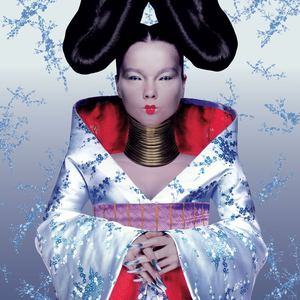
"I wanted to make it an honest record. Me, here, myself, at home. I asked myself if there is such a thing as Icelandic techno, and how it could sound. Well, in Iceland, everything revolves around nature, 24 hours a day. Earthquakes, snowstorms, rain, ice, volcanic eruptions, geysers... Very elementary and uncontrollable. But at the other hand, Iceland is incredibly modern; everything is hi-tech. The number of people owning a computer is as high as nowhere else in the world. That contradiction is also on Homogenic. The electronic beats are the rhythm, the heartbeat. The violins create the old-fashioned atmosphere, the colouring. Homogenic is Iceland, my native country, my home." Homogenic is the third studio album by Icelandic singer-songwriter and musician Björk, released on 23 September 1997 by One Little Indian and Elektra Records. It was written in collaboration with producer Mark Bell of LFO. It has sold over 2.3 million copies worldwide. Björk continually describes Homogenic as an extension of her personal feelings. In interviews, she called the album her "most me yet" and "emotionally confrontational." Claiming that there are no surprises on Homogenic, Björk wanted to make a minimalist album with few tools: a string orchestra, vocals, and synthetic beats. She has revealed that the album's name stems from the fact that all of the tracks are relatively similar and did not realise that "homogenic" is not actually an English word, referencing English as her second language. Homogenic was extremely well received by critics and the general public. Allmusic's Heather Phares gave the record a five-out-of-five star rating, citing it as more emotionally deep than any of Björk's previous work and a "seamless fusion of chilly strings, stuttering, abstract beats, and unique touches like an accordion and glass harmonica." Writing a review of the album for Pitchfork Media, Ryan Schrieber graded Homogenic as an 9.9-out-of-10, claiming that Björk has started to re-define what music actually is rather than its sound. Rolling Stone praised the juxtaposition and contradiction of live strings and synthesised beats, eventually naming it one of the boldest albums of 1997. Read more on Last.fm.
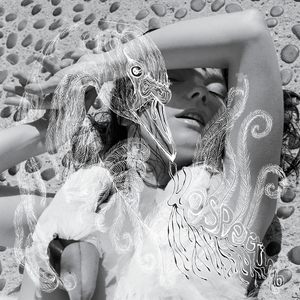
Vespertine, released in August 2001, is an album by the Icelandic singer/songwriter/musician Björk. It sees Björk creating an introverted, quiet world of swirling microbeats and personal lyrics. On the cover she can be seen wearing the swan dress (designed by Marjan Pejoski) that caused a stir at the 2001 Academy Awards. Björk uses an array of sampled objects to create beats and soundscapes in a number of songs on Vespertine, including shuffling cards on "Cocoon" and "Hidden Place"; snow being walked upon on "Frosti", and ice being cracked and smashed on "Aurora". Vespertine is Björk's longest album, at 55:33 (apart from compilations). "Hidden Place", "Pagan Poetry" and "Cocoon" were released as singles from the album. A rumoured fourth single, "It's Not Up to You", never made it to release, presumably because of the birth of Björk's daughter Isadora. The lyrics to "An Echo, A Stain" are taken from Sarah Kane's play Crave. The lyrics of "Harm of Will" were written by Harmony Korine and are about Will Oldham. The last track on the album, "Unison," uses a sample of St Paul's Cathedral Choir singing a segment of Patrick Gowers's Viri Galilaei recorded in 1994. Read more on Last.fm.
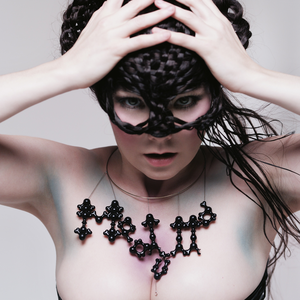
Medúlla, meaning "marrow" in Latin, is an album by Icelandic singer/songwriter/musician Björk, which was released on 30 August 2004 (see 2004 in music). The album is almost entirely a cappella and constructed with human vocals; only few musical instruments are featured: a bass synthesizer on "Who Is It" and "Mouth's Cradle", piano on "Ancestors" and a gong on "Pleasure Is All Mine". However, the vocals are sometimes processed or sampled: for example, the atmospheric haze that dominates "Desired Constellation" was created from a sample of Björk singing the phrase "I'm not sure what to do with it" from "Hidden Place" on her previous album, Vespertine. The album features beatboxing, choral arrangements and throat singing, as well as guest appearances by such artists as Mike Patton, Robert Wyatt, Tagaq, Rahzel (formerly of The Roots), Shlomo and Dokaka. All songs were written by Bjork, except the lyrics for "Sonnets/Unrealities XI" which was based on a poem by E. E. Cummings, and the song "Vökuró", originally by Jórunn Viðar. Björk received two Grammy Award nominations for Medúlla, including Female Pop Vocal Performance for "Oceania", and Alternative Music Album. This album is also featured in the book 1001 Albums You Must Hear Before You Die The album reached a position of number nine on the UK Albums Chart, number 14 on the U.S. Billboard 200 (her highest position until Volta 2007 debut at no.9), and number one in Estonia, France, Iceland and Belgium (Wallonia). The album was originally released both on CD and on DVD-Audio in 5.1-channel advanced resolution. The album was re-released in 2006 as a DualDisc including a lower-quality DTS 96/24 version of the original advanced resolution 5.1 mix. The DualDisc also formed part of the ( surrounded): box set. Medúlla as since sold 235,000 copies in the U.S. and more than a 1 million worldwide. Read more on Last.fm.
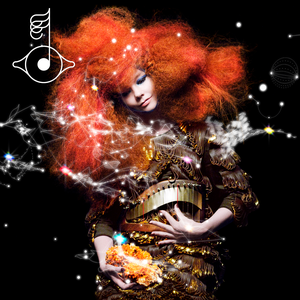
Biophilia Educational Project: http://biophiliaeducational.org/ Biophilia is the musical project and eighth full-length studio album from Icelandic singer Björk. The album was released on October 10, 2011, over four years after her last original studio effort Volta (2007). The album is "partly recorded" on an iPad and will be released in the form of a series of apps. Biophilia will be the world's "first app album" in collaboration with Apple. Björk has described the project as a multimedia collection "encompassing music, apps, internet, installations and live shows". Material from the album was debuted during a concert series which was held in the summer of 2011 at the Manchester International Festival. Music from Biophilia first appeared in the iPad app "Solar System". The app, developed by Touch Press and Faber and Faber and written by author Marcus Chown, is an eBook with interactive 3D objects, movies, animations, and diagrams "based on real scientific data", along with images from NASA, the European Space Agency and the Japan Aerospace Exploration Agency. From June, every song in the album will be released as a single app for iPad, twice a month. The first song to be released as an app (which is also considered the first single) is "Crystalline". The video was directed by long-time collaborator Michel Gondry and shot on May 26. "Biophilia" for iPad will include around ten separate apps, all housed within one "mother" app. Each of the smaller apps will relate to a different track from the album, allowing people to explore and interact with the song's themes or even make a completely new version of them. It will also be an evolving entity that will grow as and when the album's release schedule dictates, with new elements added. Scott Snibbe, an interactive artist who was commissioned by Björk back in the summer of 2010 to produce the app, as well as the images for the live shows (which will combine his visuals with National Geographic imagery, mixed live from iPads on the stage), describes how Björk saw the possibilities of using apps, not as separate to the music, but as a vital component of the whole project. For one song, "Virus", the app will feature a close-up study of cells being attacked by a virus to represent what Snibbe calls: "A kind of a love story between a virus and a cell. And of course the virus loves the cell so much that it destroys it." The interactive game challenges the user to halt the attack of the virus, although the result is that the song will stop if the player succeeds. In order to hear the rest of the song, the players will have to let the virus take its course. Using some artistic license, the cells will also mouth along to the chorus. It's this determination to fuse different elements together, be it juxtaposing a female choir from Greenland with the bleeps and glitches of electronic music pioneers Matmos during the Vespertine tour, or meshing soaring strings and jagged beats on Homogenic, that "helps explain the power and success of Björk's collaborations". Read more on Last.fm.
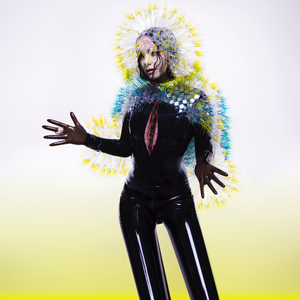
Vulnicura is the ninth (officially considered to be the eighth) studio album by Icelandic musician and singer Björk. It was produced by Björk, Arca and The Haxan Cloak, and released on 20 January 2015 by One Little Indian Records. Björk said the album expresses her feelings before and after her breakup with American contemporary artist Matthew Barney and the healing process. Vulnicura was originally scheduled for release in March 2015, in conjunction with the Björk: Archives book and an exhibition about Björk's career at the Museum of Modern Art in New York City; following an internet leak, it was released digitally two months early. No singles were released to promote the album but a series of innovative music videos were created, culminating in the 360-degree virtual reality exhibit Björk Digital. Read more on Last.fm.